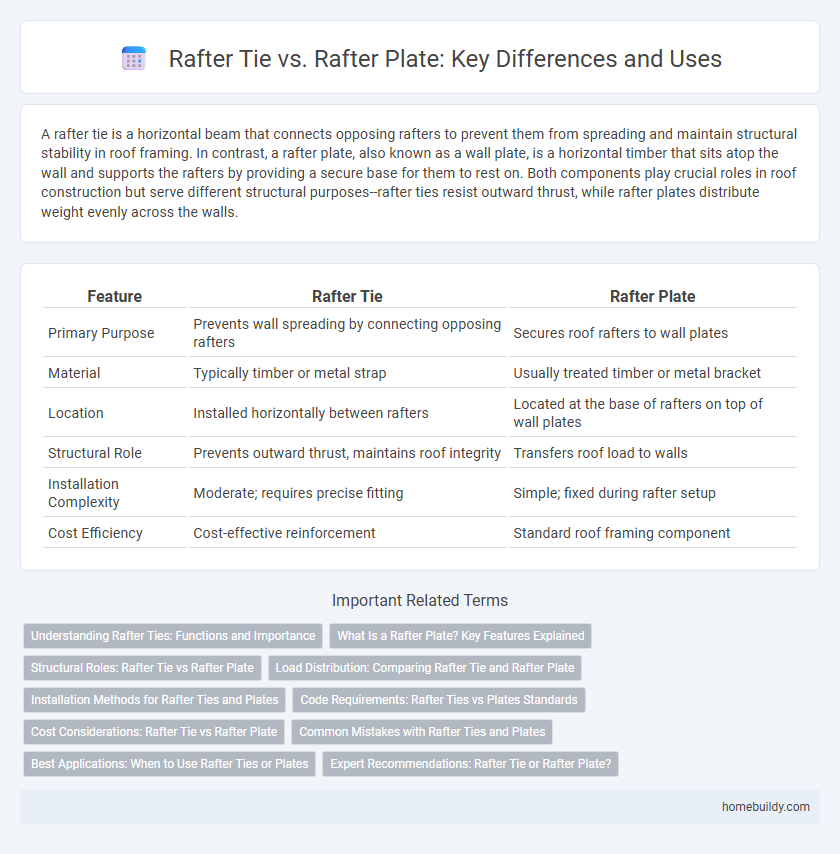A rafter tie is a horizontal beam that connects opposing rafters to prevent them from spreading and maintain structural stability in roof framing. In contrast, a rafter plate, also known as a wall plate, is a horizontal timber that sits atop the wall and supports the rafters by providing a secure base for them to rest on. Both components play crucial roles in roof construction but serve different structural purposes--rafter ties resist outward thrust, while rafter plates distribute weight evenly across the walls.
Table of Comparison
| Feature | Rafter Tie | Rafter Plate |
|---|---|---|
| Primary Purpose | Prevents wall spreading by connecting opposing rafters | Secures roof rafters to wall plates |
| Material | Typically timber or metal strap | Usually treated timber or metal bracket |
| Location | Installed horizontally between rafters | Located at the base of rafters on top of wall plates |
| Structural Role | Prevents outward thrust, maintains roof integrity | Transfers roof load to walls |
| Installation Complexity | Moderate; requires precise fitting | Simple; fixed during rafter setup |
| Cost Efficiency | Cost-effective reinforcement | Standard roof framing component |
Understanding Rafter Ties: Functions and Importance
Rafter ties are critical structural components that prevent outward spreading of roof rafters, maintaining the integrity of the roof frame under load. Unlike rafter plates, which support rafters at their base on top of the wall, rafter ties connect opposing rafters at the ceiling level, counteracting tension forces and preventing wall deformation. Proper installation of rafter ties enhances the roof's stability, minimizes structural movement, and contributes to the overall durability of the building framework.
What Is a Rafter Plate? Key Features Explained
A rafter plate is a horizontal timber fixed at the top of a wall to provide a stable base for rafters, ensuring load distribution and structural integrity in roof framing. Unlike a rafter tie, which connects opposing rafters to prevent them from spreading, the rafter plate acts as a supportive ledger that anchors rafters securely to the building's framework. Key features include its role in maintaining roof alignment, enhancing load transfer, and facilitating secure attachment of rafters to walls.
Structural Roles: Rafter Tie vs Rafter Plate
Rafter ties prevent roof spread by connecting opposing rafters at their lower ends, ensuring lateral stability and reducing outward thrust on walls. Rafter plates serve as base support for rafters, distributing roof loads evenly across wall tops to maintain structural integrity. Understanding the distinct roles of rafter ties and rafter plates is crucial for effective roof framing and load management.
Load Distribution: Comparing Rafter Tie and Rafter Plate
Rafter ties effectively resist outward thrust by connecting opposing rafters, distributing roof loads evenly across the structure and reducing wall spreading. Rafter plates, installed at the base of rafters, primarily provide a secure bearing surface onto the top plate of walls but do not significantly counteract lateral forces. For optimal load distribution, rafter ties serve a critical role in maintaining structural integrity under varying loads, while rafter plates ensure stable attachment points without directly influencing horizontal load resistance.
Installation Methods for Rafter Ties and Plates
Rafter ties are typically installed horizontally between opposing rafters, secured with nails or screws to prevent roof spreading and increase structural stability. In contrast, rafter plates are fixed directly onto the top of the wall plate or between rafters, often using metal connectors or anchors to provide a stable base. Proper installation of both involves precise alignment and fastening to ensure roof integrity and load distribution.
Code Requirements: Rafter Ties vs Plates Standards
Rafter ties are specifically designed to resist uplift forces and prevent roof spreading according to International Residential Code (IRC) Section R802.5.1, requiring minimum 2x4 lumber installed in each rafter bay. Rafter plates, often used as metal connectors, must comply with ASTM standards and provide adequate shear strength but do not replace the structural function of rafter ties under code mandates. Building codes prioritize rafter ties for lateral stability and roof integrity, while plates serve as supplemental connectors rather than substitutes for the critical tension capacity of rafter ties.
Cost Considerations: Rafter Tie vs Rafter Plate
Rafter ties typically offer a more cost-effective solution compared to rafter plates due to lower material and installation expenses, making them ideal for budget-conscious roofing projects. Rafter plates, while generally more expensive, provide enhanced structural stability and load distribution, which can reduce long-term maintenance costs. Evaluating initial costs alongside durability and performance is crucial for selecting between rafter ties and rafter plates in construction budgeting.
Common Mistakes with Rafter Ties and Plates
Common mistakes with rafter ties include improper sizing and incorrect placement, which can compromise roof stability and lead to structural failure. Rafter plates often suffer from insufficient fastening or use of inadequate materials, reducing their effectiveness in holding rafters securely. Ensuring proper installation and using the correct hardware for both rafter ties and plates is crucial to maintaining roof integrity and preventing costly repairs.
Best Applications: When to Use Rafter Ties or Plates
Rafter ties are best used in scenarios where preventing roof spread and maintaining structural integrity is critical, especially in traditional timber framing or open attic spaces. Rafter plates, also known as connector plates, provide a strong, metal connection ideal for prefabricated truss systems and rapid assembly in modern construction. Selecting between rafter ties and plates depends on factors like roof design, load requirements, and whether the application prioritizes flexibility or prefabricated precision.
Expert Recommendations: Rafter Tie or Rafter Plate?
Expert recommendations for roof framing often favor rafter ties over rafter plates due to their superior ability to resist outward thrust and maintain structural integrity. Rafter ties, typically installed horizontally between opposing rafters, effectively prevent roof spreading and enhance stability, especially in traditional timber framing. Rafter plates serve as bearing elements but lack the tension resistance provided by rafter ties, making ties the preferred choice for load distribution and long-term durability.
Rafter tie vs Rafter plate Infographic

 homebuildy.com
homebuildy.com